

5 Places To Find Free Educational eBooks. Hunting down classic literature and important manuscripts may mean more than a quick Google search for many of us. You may turn to paid sources like Amazon or even (the humanity!) Turn to printed books in your library. The horror! We kid. We love the library and feature effective ways to use libraries all the time. So what happens when Google, Amazon, and your local library come up short in your quest for free educational eBooks? The Harvard Classics Some of the most important works of literature are a part of the dozens of volumes available in The Harvard Classics.
An Infographic Guideline For Making Good Infographics. 5 Fun Online Games that Disguise Important Lessons. Of all the impact education technology can have in the classroom, it is at its most powerful when students are enjoying themselves so much they don’t even realize they are learning!

These brilliant online games each help students learn about important new skills, issues or ideas, but they are guaranteed to enjoy themselves at the same time! 1. Immune Attack An incredibly exciting and addictive game from the Federation of American Scientists, which students will never want to stop playing! Players navigate a ‘nanobot’ through the inside of the human body, exploring an environment of 3D blood vessels and connective tissue with the goal of saving an ailing patient. Student Interactives. ReadWriteThink has a variety of resources for out-of-school use. Visit our Parent & Afterschool Resources section to learn more. More Home › Classroom Resources › Student Interactives Engage your students in online literacy learning with these interactive tools that help them accomplish a variety of goals—from organizing their thoughts to learning about language—all while having fun. 1 | Grades K – 12 | Student Interactive | Organizing & Summarizing Story Map.
6 Great Videos on Teaching Critical Thinking. Critical thinking is a skill that we can teach to our students through exercise and practice.
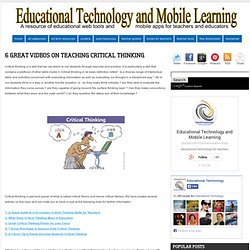
What Does Critical Thinking Mean in Education ? Critical thinking is an important skill in the 21st century learning.

Education's overall goal is to produce students that will be able to think critically and not just take in things like a parrot. Of course thereis a bunch of other important skills out there but this particular one stands out from the crowd. The thing about ttis skill is that while almost all teachers agree upon its priority in education only few really know what it really means. Sometimes the lines between some technical temrs are blurred as is the case in the educational jargon when refering to critical thinking as synonymous with creative thinking, a blunder that is though seemingly unimportant yet it can make all the difference for experts.
Creative Web 2.0 Learning. Web 2.0 for the Under 13s crowd. Jul 05.

Creative APP-titude: iPad Multimedia Tools for Creativitity. 5 Steps to Raising a Creative Child. APIs & Developer Products. Students Learning From Their Blogging Buddies. Posted by Mrs Kathleen Morris on Tuesday, March 27th 2012 I seem to be continually uncovering more and more benefits to educational blogging.
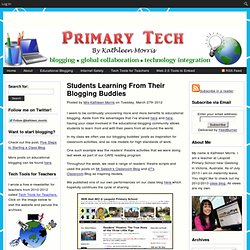
Aside from the advantages that I’ve shared here and here, having your class involved in the educational blogging community allows students to learn from and with their peers from all around the world. In my class we often use our blogging buddies’ posts as inspiration for classroom activities, and as role models for high standards of work. One such example was the readers’ theatre activities that we were doing last week as part of our CAFE reading program. Throughout the week, we read a range of readers’ theatre scripts and used the posts on Mr Salsich’s Classroom Blog and 4T’s Classroom Blog as inspiring models. We published one of our own performances on our class blog here which hopefully continues the cycle of sharing. Best Practices For Writing For Online Readers. I have less than 30 seconds to capture your attention with this post, so here goes: if you read some, most or all of the next 750 words or so, you will know how to write Web copy that is more useful to readers of your blog or Web site.
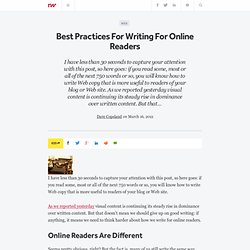
As we reported yesterday visual content is continuing its steady rise in dominance over written content. But that doesn't mean we should give up on good writing: if anything, it means we need to think harder about how we write for online readers. Online Readers Are Different Seems pretty obvious, right? But the fact is, many of us still write the same way online as we do for books, magazine articles and other long-form and traditional print mediums. With offline readers, we can take our time and develop points with long blocks of text and narrative, and with fewer visual elements. In Plain English, Please Your writing - offline or online - is effective when readers take away your message.
Blogging - Adding images and attribution : Challenge Yourself to Blog.
Teaching with Technology - Using Technology to Support Critical Thinking. Twenty Everyday Ways to Model Technology Use for Students. I wanted to post a list that talked about how to "use" technology in the classroom, but I found myself revising that word "use" to the more general word, "model.

" The reason I did this is because so many teachers believe that if students aren't actively sitting in front of the computer screen themselves, then clearly technology is not being used in the classroom. This myth can be a gatekeeper of sorts for many teachers, and I wanted to create a list that both gives advice on how to "use" but also acknowledges that in simply modeling the use the of technology, the students are also learning to use it in an indirect way. It's all about Think Aloud, that age-old trick of simply narrating everything you are doing as the wiser, more experienced brain in the room.
Narrate your decisions and your rationale and you will be teaching your students how to make good decisions online and off. Good behavior online is trickle down, after all. . #1. . #2. . #3. . #4. . #5. . #6. . #7. . #8. . #9. . #10. 5 Awesome Things You Can Do With an IPad and an LCD Projector. Global Collaboration in Kindergarten. Map of the classes we connected with through twitter and postcard exchange Here are three projects that I participated in last year that helped connect my class to the outside world.

The map above represents the connections we made through these projects. I hope you will consider joining these projects or sharing this post with others that might.. Kindergarten Around the World is a twitter-based virtual exchange project, allowing young students to experience and explore a way of life different from their own, by building a relationship with a class of similarly-aged children. Managing ICT as a Change Agent in Schools. Technology Integration Matrix. 14 Edtech Integration Tips & 20+ Resources for the School Year. 4th post in a new series: PLN Tips 4 Teachers and Goal 17: Integrate Technology Effectively of The 30 Goals Challenge for Educators “Technology is just a tool.
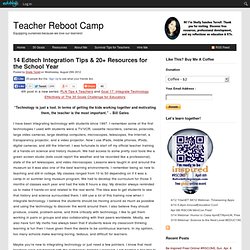
In terms of getting the kids working together and motivating them, the teacher is the most important.” ~ Bill Gates I have been integrating technology with students since 1997. I remember some of the first technologies I used with students were a TV/VCR, cassette recorders, cameras, polaroids, large video cameras, large desktop computers, microscopes, telescopes, the Internet, a transparency projector, and a video projector. Now I use iPads, mobile phones, iPods, digital cameras, and still the Internet. 50 Ways to Integrate Technology - Ways to Anchor Technology in Your Classroom Tomorrow.
Using Free Websites as Learning & Teaching Tools 1.
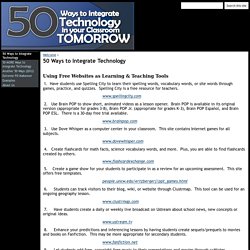
Have students use Spelling City to learn their spelling words, vocabulary words, or site words through games, practice, and quizzes. Technology That "Actually" Works. Skyping is the Next Best Thing to Being There. Tech for Teachers Skyping Is the Next Best Thing to Being There Jason T. Bedell ASCD Express's Tech for Teachers column, by guest columnist Jason Bedell, uses both text and a tutorial video to encourage teachers to bring web technology into their practice in simple but meaningful ways that can contribute to student engagement and learning. Over the last few years, Skype has become one of those indispensable apps I install on every computer, smartphone, and tablet that I use, because it lets me easily communicate with people all over the world.
Skype can be installed on pretty much everything. Thinking Tools. Critical thinking web. Critical thinking. Critical Thinking. Six Vintage-Inspired Animations on Critical Thinking. ClassTools.net: Create interactive flash tools / games for education. Patterns: Learning, Thinking, Creating. By Kevin Washburn, on January 10th, 2012 It seems contradictory. The brain seeks and sees patterns, but when asked to find patterns, many people become uneasy.
(Shelley Carson suggests that up to 80% of people find this type of thinking “uncomfortable.”1) This conundrum is the result of effort. When the brain instantly sees a pattern, it seems like a new insight has been sparked. When the brain has to search to find patterns, the rationalization begins. Patterns and the Brain “Patterns” was a major theme at the November Learning and the Brain Conference in Boston. Patterns are the cement of memory. Patterns and Teaching. MathsNet and NRich Maths 3D shape resource heaven. MathsNet have a wonderful collection of 3D shape resources at this webpage. There are a variety of interactive applets that cover 3D shape topics including nets and 2D views of 3D shapes. My particular favourite is ‘Building Houses 2′ where pupils have to build the 3D shape by using the 2D views given. They score maximum points by using the minimum number of blocks possible. Real World Math - ideas for using Google Earth in math class. Real World Math is a site with lessons and ideas for using Google Earth in the math classroom.
Web 2.0 Tools for Schools. Free Online Tools to Create Infographics. Infographics and data visualizations have become incredibly popular ways to impart information while keeping your audience engaged. 50sites ver3. Over 100 Incredible Infographic Tools and Resources (Categorized) This post is #6 in DailyTekk’s famous Top 100 series which explores the best startups, gadgets, apps, websites and services in a given category. Total items listed: 112. Time to compile: 8+ hours. Exploratree - Exploratree by FutureLab. Teaching-with-Technology - Promotingthinking. Kathy Schrock's Guide to Everything.
It Is Not About the Gadgets - Why Every Teacher Should Have to Integrate Tech Into Their Classroom. Creating Infographics. Do I just Google that? Tools for Teaching Search Skills in the Primary Classroom. Effective Digital Learning. I was asked yesterday what I considered to be the four components of effective digital learning. Notetaking Apps - a comparison of some popular ones. Notetaking apps are a great way to get organized and keep track of everything electronically.
There are a lot of different ones out there, so I thought I would go through some of the more popular ones and list some of the features they have. Click on the links for more information on each one also. Crocdoc – Collaborative Document Editing. Written by Mark Brumley. 12 Puzzle and Quiz Creation Tools for Teachers. Top 5 Websites for Teachers to Use in Their Classrooms. The 5 Best Fact-Checking Websites. Great Websites To Develop Students Vocabulary. The Best Places To Create (And Find) Internet Scavenger Hunts & Webquests. The Five Best Places To Find Free Creative Commons Photos. Top 100 Learning Game Resources. 28 free apps for teachers - Education.
E-learning tools. Spider Scribe - Mind Mapping with Images, Maps, and More. 18 Free Mind Mapping Tools for Teachers and Students. What Is Successful Technology Integration? 10 Great Tools for Tech Savvy Teachers. EduClipper: The Pinterest of Education. Three Habits for Optimal Brain Health. Blooms-quick sheets. «Free digital tools in Blooms. Bloom’s Taxonomy Re-imagine & Digital Blooms: different ways to approach learning. The Best Videos For Educators In 2011. The Best Resources For Helping Teachers Use Bloom’s Taxonomy In The Classroom. Poster Production - Get Inspired with Automotivator. Box of Tricks. 10 Videos You Could Use to Inspire Writing. 35 Sources for Curated Educational Videos. 35 Best Websites for Free Educational Videos.
Top 12 Comprehension Apps. 5 Places to Get Digital Textbooks. eReaders & eBooks in the Classroom. How Interactive Ebooks Engage Readers and Enhance Learning.